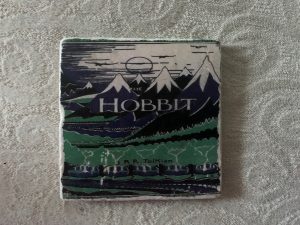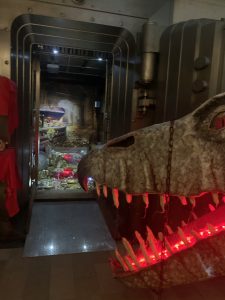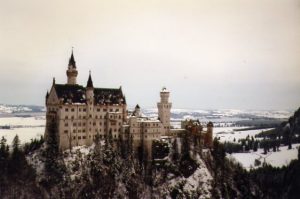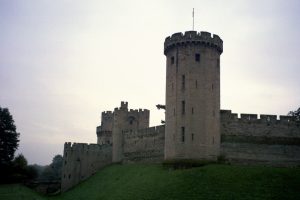Last weekend I got around to the previous weekend’s planned movie viewing, with some fantasy from the 1980s.
First up, I tried watching The Dark Crystal but didn’t make it very far into it because it hit some serious uncanny valley stuff for me with the hero, who at times was very puppet-like but then was a bit too human for comfort. I also couldn’t follow all the story that was infodumped by a narrator at the beginning. So I gave up and ended up watching the US figure skating national competition.
Then on Saturday night, it was Ladyhawke. I have really mixed feelings about that movie. On the one hand, I love it, but on the other, it’s pretty seriously flawed.
In case you’re not up on 80s fantasy, this is the story about a young thief (a rather miscast Matthew Broderick, who half the time sounds like he’s doing Ferris Bueller—before he was Ferris Bueller—and half the time sounds like he’s trying to do a fantasy European-ish accent), who escapes from an evil bishop’s prison, then is rescued from recapture by a mysterious knight (Rutger Hauer) who wants his help getting back into the bishop’s citadel so he can kill the bishop. It turns out that the bishop used dark magic to curse the knight and his love (Michelle Pfeiffer) so that the knight is human by day and the woman a hawk, then the knight is a wolf by night while the woman is human. They’re always together, but also always apart. Then the priest who unintentionally betrayed them finds a way to break the curse, but the knight can’t bring himself to trust him. Can the young thief scheme to help his friends?
The main flaw is the score, which doesn’t fit at all. Whoever thought it was a good idea to put an electronic disco-style score on a fantasy movie needs counseling. There are moments in the movie that have a lovely traditional soundtrack, and they really work well. There’s a part when the hawk is flying over the water and the music is gorgeous, perfect for the scene. Then there’s another moment when the lady is next to the wolf when the transition happens, and for a split second they can almost see each other. It starts with the disco score, but then the synth pulls out and it becomes more traditional movie music, which works so much better. You can hear the orchestral line that should be there in the disco stuff, so it’s like we’re getting the disco remix of the real score. It’s mostly in the action scenes (and sometimes goes off into wacky cartoon-style music for a chase scene that should be tense), and it throws me right out of the movie every time.
Another issue is the fact that the difference between day and night is extremely important to the plot, but it’s hard to tell the difference because it looks like they did “day for night” filming using blue filters to make it look like night, but half the time the woman is human, it practically looks like broad daylight. They’ve gone overboard in making things dark these days, so you can’t see what’s going on, but there has to be a middle ground, where you can see what’s happening but you can also tell that it’s night.
As much as they like remaking things these days, I wouldn’t mind a remake of this one. The story is quite good, but this isn’t such a perfect movie that it would be blasphemy to make a new version (like, say, The Princess Bride). I was pondering what would need to be changed other than the score and the night filming, and maybe some of the casting (Matthew Broderick was the big name in the cast at the time, but he’s also kind of a weak link because he’s just a bit too extra. Even when I was a teenager seeing this before Ferris Bueller existed, he made me cringe). Not that this cast is bad, but the accent inconsistency is weird. The main characters speak with (mostly, in Broderick’s case) American accents, including Rutger Hauer, who only occasionally has a slight inflection that suggests this isn’t his native language. Everyone else with a speaking role (which isn’t a lot—they must have been careful to keep the speaking parts to a minimum) has a British accent. But they’re all from the same place. I like that they didn’t try to show the transition between animal and human forms with any kind of special effects. They just used editing and framing the shots, and I wouldn’t want them to try to morph using CGI now.
I think if I were given the assignment to update it, I’d make the thief a girl and create an unrequited love triangle, not for the romance, but for the moral dilemma. If it’s a girl who gets rescued by a handsome knight, she might develop a crush on him before she learns that the hawk that travels with him is the woman he loves. Then when they learn there’s a way to break the curse and the knight rejects it, wanting to go through with his plan to kill the bishop (which will result in the curse being permanent), the thief would have to decide whether to do what the knight wants, thus making him happy and essentially getting him for herself, or to go behind his back to help break the curse and thus make him angry if it fails and lose all hope of being with him if it succeeds.
Then I started trying to think of a way to file the serial numbers off it and write that story. I could make the way to break the curse better and more of a dilemma (in the movie, breaking the curse involves being in the same place as they’d be to kill the bishop, so I don’t see why they didn’t try for the breaking, then have killing the bishop as plan B or a follow-up. I’d make it a true either/or where having both would be impossible). The trick is coming up with a “always together, forever apart” curse that’s not obviously a ripoff of Ladyhawke.
I’m actually writing a similar triangle now, with a woman traveling with a man who’s on a mission to save a different woman, and as she falls for him, she’s torn between helping him save the woman he loves and holding back to maybe win him for herself, but she never meets the other woman and he’s never been involved with that woman. It’s been a crush from afar on his part and he’s hoping this heroism will help him win her. It’s not like Ladyhawke, where the thief becomes friends with both and passes messages between them and they were in an established relationship before they were cursed to keep them apart. Mine is a bit more like Stardust but with the woman he’s trying to win actually being in danger. He’s not just doing this to win her.
The trick with the more Ladyhawke situation would be resolving the triangle. If the thief is the viewpoint character, then we’d be pulling for her to win the knight. It would be disappointing to go through the whole thing with her sacrificing her own happiness for the man she loves, only to be left aside as he goes back to his love, but he looks like a jerk if he ditches the woman he was cursed for because of a girl he just met. The whole idea of Ladyhawke is that these were people and animals who mated for life but were kept apart, so they were doomed to be alone. You’d have to make the thief realize it was just a crush and she wants them to be together. Maybe she finds a more suitable love interest along the way.
Actually, if they could digitally make night more night-like and replace the score, they wouldn’t have to remake Ladyhawke. I think it would hold up pretty well with different music. Other than that, it doesn’t scream “80s!” too badly. They did a decent job of making it a fantasy world that didn’t look obviously made in the 80s.
With the end of January approaching, I’m trying to decide what my next movie theme should be. I’m not really in the mood for rom-coms or romances for Valentine’s Day. I’ve been thinking of doing a big Star Wars rewatch to build up to Andor season 2, which would include rewatching Clone Wars and Rebels, so I’d need to start with the prequel movies, then it might take a month or two to get through all the animated stuff that comes in between. Or I could extend fantasy month. I haven’t seen the extended editions of the Hobbit movies, but those are already so bloated. Are they like the LOTR extended editions, where the extra stuff is all the character development that makes things make more sense, or is it just more swarms of orcs?




